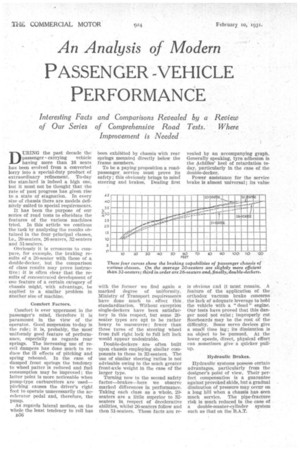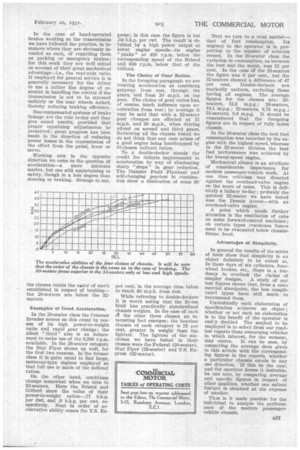An Analysis of Modern
Page 126

Page 127

If you've noticed an error in this article please click here to report it so we can fix it.
PASSENGER -VEHICLE PERFORMANCE
Interesting Facts and Comparisons Revealed by a Review of Our Series of Comprehensive Road Tests. Where Improvement is Needed
DURING the past decade the passenger carrying vehicle having more than 16 seats has been evolved from a converted lorry into a special-duty product of extraordinary refinement. To,day the stan.lard is indeed a high one, but it must not he thought that the rate of past progress has given rise to a state of stagnation. In every size of chassis there are models definitely suited to special requirements.
It has been the purpose of our series of road tests to elucidate the features of the various machines tried. In this article we continue the task by analysing the results obtained in the four principal classes, i.e., 20-seaters, 26-seaters, 32-seaters and 51-seaters.
Obviously it is erroneous to compare, for example, the braking results of a 20-seater with those of a double-decker, but the comparison of class results may prove instructive; -it is often clear that the results of concentrated development of one feature of a certain category of chassis might, with advantage, be applied to a similar problem in Another size of machine.
Comfort Factors.
Comfort is ever uppermost in the passenger's mind, therefore it is paramount in the view of the operator. Good suspension to-day is the rule; it is, probably, the most uniformly good feature of performance, especially as regards rear springs. The increasing use of recoil dampers has done much to reduce the ill effects of pitching and spring rebound. In the ease of damped front springs the tendency to wheel patter is reduced and fuel consumption may be improved ; the latter point is more noticeable when pump-type carburetters are used— pitching causes the driver's right foot to operate unnecessarily the accelerator pedal and, therefore, the pump. • As regards lateral motion, on the Whole the least tendency to roll has D56 been exhibited by chassis with rear springs mounted directly below the frame members.
To be a paying proposition a roadpassenger service must prove its safety; this obviously brings to mind steering and brakes. Dealing first with the former we find again a marked degree of uniformity. Ministry of Transport requirements have done much to effect this , standardization. Without exception single-deckers have been satisfactory in this respect, but some 20seater types are apt to be rather heavy to manceuvre; fewer than three turns of the steering wheel from full right lock to full left lock would appear undesirable.
Double-deckers . are often built Upon chassis employing similar components to those in 32-seaters. The use of similar steering ratios is not advisable owing to the much greater front-axle weight in the case of the larger type.
Turning now to the second safety factor—brakes—here we observe marked differences in performance. Taking each class as a whole, 20seaters are a little superior to 32seaters in. respect of decelerative abilities, whilst 26-seaters follow and then 51-seaters. These facts are re
vealed by an accompanying graph. Generally speaking, tyre adhesion is the Achilles' heel of retardation today, particularly in the case of the double-decker.
Power assistance for the service brake is almost universal; its value is obvious and it must remain. A feature of the application of the orthodox vacuum brake concerns the lack of adequate leverage to hold the vehicle with a " dead " engine. Our tests have proved that this danger need not exist; improperly cut floorboards may be the root of the difficulty. Some servo devices give a small time lag ; its diminution is an object to be pursued. At the lower speeds, direct, physical effort can sometimes give a quicker pullup.
Hydraulic Brakes.
Hydraulic systems possess certain advantages, particularly from the designer's point of view. Their perfect compensation is a guarantee against provoked skids, but a gradual diminution of pressure may occur on a long hill when a chassis has seen much service. The pipe-fracture risk is much reduced in the case of a double-master-cylinder system such as that on the B.A.T. In the case of hand-operated brakes working on the transmission we have followed the practice, in instances where they are obviously intended as such, of regarding them as parking or emergency brakes; for this work they are well suited on account of their great mechanical advantage—i.e., the rear-axle ratio. If employed for general service it is generally necessary for the driver to use a rather fine degree of restraint in handling the control if the transmission is not to be stressed unfairly or the rear wheels locked, thereby reducing braking efficiency.
Non-compensated systems of brake linkage are the rule to-day and they give sound results, provided that proper eqtalizing adjustments be preserved ; great progress has been made in the direction of reducing power losses in the transmission of the effort from the pedal, lever or servo.
Working now in the opposite direction we come to the question of acceleration—a more intricate matter, but one still appertaining to safety, though in a less degree than steering or braking. Strange to say,
the classes retain the owler of merit established in respect of braking—. the 26-seaters are below the 32seaters.
Examples of Good Acceleration.
In the 20-seater class the Commer Invader scores on this count by reason of its high power-to-weight ratio and rapid gear change; the silent " third " also is an inducement to make use of the 3,200 r.p.m. available. In the 26-seater category the Star Flyer shows up well, for the first two reasons. In the former class it is quite usual to find large, motorcar-type engines employed so that full use is made of the indirect ratios: On the other hand, conditions change somewhat when we turn to 32-seaters. Here the Bristol and Gilford show the value of their power-to-weight ratios—.77 b.h.p. per &wt. and .8 b.h.p. per cwt. respectively. Next in order of accelerative ability comes the T.S. Ex
press ; in this case the figure is but .54 b.h.p. per cwt. The result is obtained by a high power output at lower engine speeds—its engine " peaks " at 400 r.p.m. below the corresponding speed of the Bristol and 800 r.p.m. below that of the Gifford.
The Choice of Gear Ratios..
In the foregoing paragraph we are treating acceleration as combining getaway, from rest, through the gears, and from 10 m.p.h. on top gear. The choice of gear ratios has, of course, 'much influence upon acceleration from rest; by average it may be said that with a 32-seater gear changes are effected at 17 m.p.h. and 30 m.p.h., when driving all-out on second and third gears. Reviewing all the chassis tested we do not think that any case arises of a good engine being handicapped by la-chosen indirect ratios.
To a double-decker stands the credit for definite improvement in acceleration by way of eliminating sharp " steps " in gear reduction. The Daimler Fluid Flywheel and self-changing gearbox in combination show a diminution of some 30 per cent, in the average time taken to reach 30 m.p.h. from rest.
While referring to double-deckers it is worth noting that the 91-ton limit has practically standardized chassis weights. In the case of each tit the other three classes an interesting fact emerges; the heaviest chassis of each category is 23 per cent. greater in weight than the lightest. The lightest of the machines we have tested in their classes were the Federal (20-seater), Star Flyer (26-seater) and T.S. Express (32-seater).
Next we turn to a vital matter— that of fuel consumption. Its urgency to the operator is in proportion to the number of vehicles owned. In the 20-seater class the variation in consumption, as between the best and the worst, was 12 per cent. In the case of the 26-seaters the figure was 6 per cent., but the 32-seaters showed a difference of 47 per cent. Double-deckers are markedly uniform, excluding those having oil engines. The average figures for the classes are: 20seaters, 12.3 m.p.g.; 26-seaters, 10.1 m.p.g.; 32-seaters, 8.73 ni.p,g.; 51-seaters, 6.8 m.p.g. It should be remembered that the foregoing figures are in respect of fully laden. chassis.
In the 20-seater class the best fuel consumption was recorded by the engine with the highest speed, whereas in the 32-seater division the best fuel performance was achieved by the lowest-speed engine.
Mechanical silence is an attribute of considerable importance for modern passenger-vehicle work. At one time criticism was directed against the overhead-valve engine on the score of noise. This is definitely a fallacy to-day ; probably the quietest 32-seater we have tested was the Dennis Arrow—with an overhead-valve engine.
A point which needs further attention is the ventilation of cabs on some forward-control machines; on certain types crankcase fumes need to be evacuated below chassisframe level.
Advantages of Simplicity.
In general the results of the series of tests show that simplicity is an object definitely to be aimed at. In these days of six cylinders, fourwheel brakes, etc., there is a tendency to overlook the claims of simpler designs. A study of our test figures shows that, from a commercial standpoint, the less complicated types have still much to recoaunend them.
Undoubtedly each elaboration of specification achieves an object; whether or not such an elaboration is to the benefit of the operator is easily decided The method to be employed is to select from our roadtest reports those concerning vehicles in which interest, for the moment, may centre. It can be seen, by comparing the average data given in this article with the corresponding figures in the reports, whether a particular chassis excels in any one direction. If this be the case, and the operator deems it desirable, he can note, by comparing average and specific figures in respect of other qualities, whether one salient feature is obtained at the expense of another.
Thas is it made possible for the individual to analyse the performance of the modern passengervehicle chassis.




























































































































































































